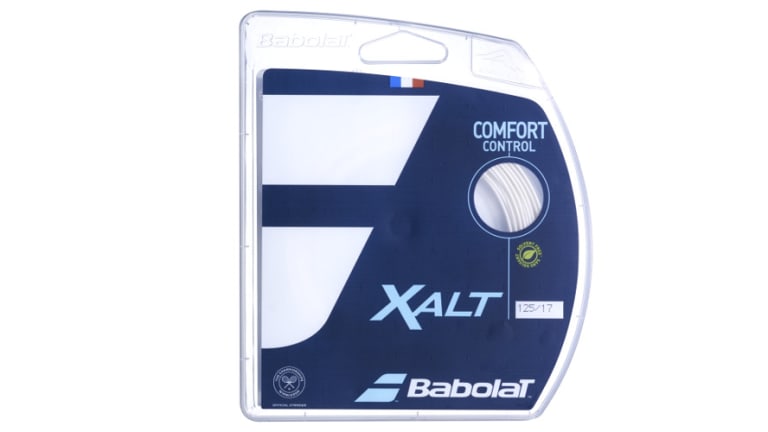Price: $22/set; $299/reel
Gauges: 16, 17
Website: babolat.com
Description
Xalt is an entirely new addition to Babolat’s Xcf family of multifilament strings. It’s composed of special polyamide filaments combined with glass beads, which is all covered by a silicone wrapping. The design is intended for players with medium swing speeds looking for comfort and control, or advanced players with fast swings who are used to the playability of a polyester string, but want something softer and more forgiving. So it’s still arm-friendly with good power, but brings a more predictable response than traditional multis.
Ease of Stringing
The slick, silicone coating of Xalt allows it to slide rather freely during installation. It has a smooth, milk-colored, almost texture-free surface. It’s not as stretchy as softer multis with a decent amount of coil memory, but limited kinking. It makes more of a sound than most when pulling, but nothing like the squeal of an RPM Power or other unusually noisy strings.
What Works
Xalt fits nicely into the class of strings (Tecnifibre Triax, Wilson NXT Control) that try to bridge the gap between the friendly feel of a multifilament and the dependability of a polyester. It’s firmer and less powerful than something like Babolat Xcel, but has a more controlled and crisper response. It’s comfortable and arm-friendly, yet stops well short of feeling mushy. Overall, there’s generally a good sense of where the ball is on the string bed.
At contact there’s nice pocketing, with shots coming off the strings with plenty of pace and reliable management. There’s greater confidence taking bigger cuts on the ball than when using a more powerful multi. Ground strokes have a more linear ball flight than one would typically get from co-polyester, requiring a lower target window over the net. The upside is flatter and slice shots—especially serves—penetrate more quickly through the court.
The slick coating does give the strings a bit more snapback as well. String realignment is needed for those who do hit with more spin, especially after a few hours of play, but it’s not excessive. I didn’t try it in a hybrid, but it strikes me that this feature makes it a worthy candidate to use as the cross in a blend with a poly main string.
My favorite spot to use Xalt is at net. As a longtime poly user, I must confess the string is an upgrade on volleys. It puts a little extra punch on the ball, yet is still completely trustworthy. And the added feel and touch is a real bonus when trying to employ more delicate shots. Throw in the solid serving and it’s something I’d strongly consider using if I’m spending lots of time on the doubles court.
What Needs Work
The drawback for the string—not surprising for a multi—is lowered spin generation. This is more apparent if you’re coming to it from a polyester. It doesn’t grip the ball or provide the same arc to shots that comes from a shaped or textured poly. Multiple playing partners commented that my ground strokes and kick serves didn’t have same dive into the court produced by my customary string. I noticed it when needing to quickly lift and dip a mid-court ball, such as on transition approach shot down the line. In these instances, distance control can be an issue.
Durability could be another consideration, especially for bigger hitters. Although players who hit with limited spin probably won’t find it a problem. Thanks to the coating, it doesn’t unravel or fray like many multis. So tension and playability stay pretty true before it snaps. Frequent breakage isn’t necessary a problem, as long as you’re getting your money’s worth out of premium-priced string.
Who’s It For
Xalt would be a solid option for seasoned poly players looking for a kinder, more cushioned response, but don’t want to sacrifice much command. It could also be attractive to rising juniors who want greater control and feedback than they’re getting from their current multi, but aren’t quite ready for the rigors of a polyester.
